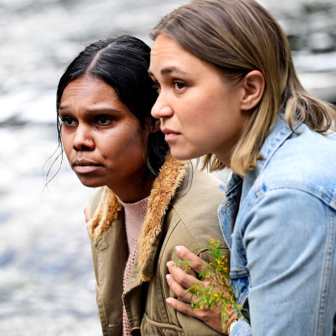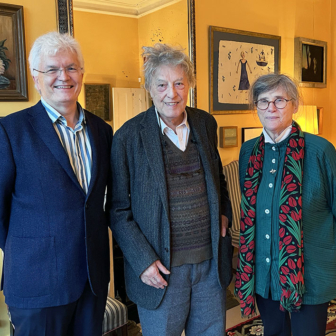Australian republicans who turned away in disgust from Harry and Meghan’s wedding celebrations a few weeks ago deprived themselves of the sight not only of a parade of remarkably silly hats but also of a visually dramatic confrontation between the High Anglican traditions of British white privilege and a livelier Christian heritage emerging from the experiences of African people in the United States. In popular British history, the country’s participation in the Atlantic slave trade disappears behind stories about William Wilberforce and the struggle for its abolition; in American history the memory is still alive in people who mark their freedom in family generations.
During the ceremony at St George’s Chapel, we were forced to recognise, just for a moment, that the wealth on such extravagant display — those flowers, the clothes, that tiara — was built on the backs of people who were slaves. In his oration, Bishop Michael Curry mentioned slavery explicitly. It was a celebration of love, but he wasn’t going to let pass the opportunity to remind those white aristocrats that their wealth was derived from the oppression of other races. The Kingdom Choir’s “Stand by Me” was both a love song for the moment and a protest song for the injustices of the past. Three cheers for Meghan, who must have orchestrated this, and for Harry, who chose her.
It worked as theatre, too, with a rare sunny day pouring light through the stained-glass windows of a medieval chapel, sacred in its destiny as the final resting place of the Queen, its class divisions made physical in the screen dividing the elite from the hoi polloi. The bishop’s energetic rhetoric and the choir’s gospel singing intruded into the high European traditions of classical music in a dauntingly impressive setting. Perhaps it was simply a theatrical performance with no impact on the lives of the people who watched it; the sprinkling of black faces in the choir stalls certainly suggested that only a few will be invited into the enclave. Yet millions of British people of African heritage saw representatives of their history mingling with those stiff symbols of white hegemony.
This symbolic acceptance of black people seemed particularly poignant at a time when the West Indian migrants from the Windrush generation were being made outcast by administrative cruelty. The monarchy can’t offer political redress but it can provide a dramatic commentary on the failures of democratic administrations in Britain and other English-speaking countries. In this light, the wedding provided a counternarrative to the current realities of British government. Perhaps it distracted attention from those realities; perhaps it can be seen as quiet criticism.
British royalty is always a public performance, but in the last few years playwrights and screenwriters have been eager to grasp the dramatic possibilities of its counternarrative role. Shakespeare’s history plays set the model for this writing, of course, though he had to please royal patrons and his shadow has inhibited more recent dramatists from attempting royal epics.
Rona Munro’s James plays, first produced in 2014 and performed at the Adelaide Festival in 2016, demonstrate the kind of nerve a writer needs to take on Shakespeare’s models. Munro was so impressed by the English Shakespeare Company’s production of Shakespeare’s history plays in sequence (performed in Canberra and Adelaide in 1988) that she was emboldened to write the stories of James I, II and III of Scotland as a trilogy in high Shakespearean style. James I: The Key Will Keep the Lock has its starting point in Shakespeare’s celebration of Henry V, but delineates the underside of Henry’s heroism by focusing on his prisoner, James, and his difficulties in claiming his crown in Scotland. The ruthless infighting of the Scottish clans and their murderous attempts on the throne make for high drama in the other plays. Performed by the Scottish National Theatre, they were an assertion of Scottish history, if not a call for independence, at a time when Scots were reconsidering their place in the Union.
Taking Shakespeare’s model as a kind of licence to speculate, Mike Bartlett’s King Charles III also appeared in 2014 (with a brief run in Sydney in 2016), exploring the Windsor family in crisis after the imagined death of the Queen. In this play, Charles finally comes to the throne only to find that the parliament is forcing him to act in a way he regards as unethical, demanding that he sign into law restrictions on freedom of speech. How should a constitutional monarch behave when democracy produces governments bent on fascism? The question is not entirely speculative in the present world. Urged by a Lady Macbeth Kate, William takes the opportunity to force Charles to abdicate.
It is quite plausible that individual members of the royal family might have more ethical sense than their parliamentary governments. We were reminded of this in the Queen’s breezy acceptance of the need for action on climate change in the documentary The Queen’s Green Planet, screened by the ABC the night after the wedding. It seems the present monarch doesn’t see this as a political issue.
Bartlett’s play dressed the outrageousness of its speculation in the formality of blank verse, with occasional direct quoting of Shakespeare to remind audiences that it was almost conventional to open with the funeral of a monarch, introduce the ghost of Princess Diana to haunt Charles, and depict Prince Harry as a contemporary version of Prince Hal, resistant to the duties of monarchy. In 2017, the BBC broadcast a shorter version of the play, encountering objections that the princes would be hurt by the ghostly depiction of their mother, not to mention the central conceit of the Queen’s death and Charles’s abdication.
Bartlett admits that he took the most liberties in depicting Kate, but he could reasonably claim that the public knows so little about her personality that he could make free with it. It is a brilliant play, in its witty language and its embroidering of what we know about the royals. It is to be hoped that the BBC version gets some free-to-air broadcast in Australia because there was so little chance to see it on stage here. Perhaps Bell Shakespeare should have a go at it.
The third monarchical drama is, of course, the Netflix television series The Crown, which references popular memories of the Queen and her family — her marriage to Philip, her coronation, the crushing of Princess Margaret’s desire for a divorced man — while placing them in the context of British postwar politics, the diminishing Empire and the miserable austerity of British life in the 1950s. Peter Morgan, the creator of the series, has experience with the material; he wrote the screenplay for the film The Queen and the series is a development of his play The Audience, which followed Elizabeth’s audiences with a series of British prime ministers. In its long seasons on stage (in the United States and Britain — but not in Australia), the play’s selection of prime ministers varied as current events made one or other of them more appropriate, and the production eventually accommodated David Cameron.
The first season of The Crown shows Churchill, the hero of the second world war, as a backward-looking traditionalist, so focused on past Empire glory that he refuses to acknowledge the people dying in London’s smog. He patronises Elizabeth and deceives her about his health, so that, with Anthony Eden also near death, she finds herself at risk of presiding over no government at all. It may not have happened quite that way — but the incompetence of a government led by a doddering old man is clear. While Elizabeth struggles to help her sister, the government’s denial of Margaret’s desired marriage reveals it as a hypocritical patriarchy.
Like the other royal plays, The Crown is wonderfully theatrical, mining the ritual moments and flamboyant costumes of regal ceremony. With film offering wider visual possibilities than the stage (rampaging elephants in Kenya, fog rising from the lakes of Sandringham), the television series relies on visual contrasts and ironic shifts to structure the drama. George VI is operated on in Buckingham Palace with a makeshift surgery under a range of spectacular chandeliers, his bloodied lung removed into a silver dish. There are beautifully orchestrated scenes, such as George’s last Christmas at Sandringham, during which local carol singers present him with a paper crown and he joins in with the singing, aware that he will soon die.
The first season of The Crown exploits Churchill’s Shakespearean sense of importance. He makes a grand entrance into the Abbey at Elizabeth and Philip’s wedding as if it had been staged for him, and refuses to sit for audiences with the monarch even when he is barely able to stand. The economies of drama mean that liberties must be taken with fact, and background information is sometimes conveyed obviously — Churchill whispers in the Abbey about Philip’s sisters being married to Nazis, Elizabeth diagnoses the car breakdown in Kenya with a reminder that she trained as a mechanic during the war. In episode eight, “Pride and Joy,” Elizabeth and Margaret sit opposite each other expressing their sibling resentment and longing for their father’s approval.
Life may not happen this way, but it is dramatically right. Most of the time, the visual contrasts convey a delicious sense of irony — Buckingham Palace, for all the glory of its furnishings, appears perpetually dark and gloomy. Certainly, you can watch The Crown for the pleasures of gossip, for the clothes and palaces, just as you can enjoy the display of wealth at Meghan and Harry’s wedding. Or you can notice the way its depiction of the individuals in the royal family, some selfish and wilful, some with good intent, reveals the limitations of complacent and patriarchal governments.
One of the uses of monarchy, then, appears to be the possibilities it offers dramatists to speculate about history and to criticise governments. Like King Charles III, The Crown makes the royal family a touchstone for the failures of parliamentary democracy. Though such democracy is failing in serious and absurd ways here as elsewhere, Australia’s constitutional monarchy precludes even the ability to explore the royal counternarrative in drama. A series of governors-general and state governors can’t provide the personality or consistency of a long-lived monarch, let alone the dramatic potential of her family’s lives. The disadvantages lie not just in our distance from the monarch but also in the impossibility of imaginative connection with royal history and its relation to parliament. In the republic of the Unites States, television dramatists created The West Wing as an alternative narrative to Bush’s presidency, but our far-flung colonial status continues to keep us from too close an identification with the symbols of government, republican or monarchical.
During the short run of King Charles III in Sydney, Australian audiences found it difficult to take any situation involving Charles and Camilla seriously, and they laughed at the ghostly appearance of Diana. Perhaps this is the reason there has been no other Australian production of the play, and no production at all of Morgan’s The Audience, despite long runs of both plays in both Britain and America. For Australians the royal family has become little more than a collection of celebrities to be gawped at for their wealth and looks or derided for the privilege they represent.
We have our own theatre company devoted to Shakespeare, but no Australian dramatist has managed to produce ambitious plays about the sources of power. We are left with the soap opera pleasures of distant royal weddings. ●




